 There is a reason we flat-iron our fluffy curls and jimmy our gelatin into “control-top” garments and calibrate our colors to the vibe of the moment.
There is a reason we flat-iron our fluffy curls and jimmy our gelatin into “control-top” garments and calibrate our colors to the vibe of the moment.
There is a reason we rewrite our heartfelt letters and pummel our poetry into prose and hunker in the bunker of all that is safe and beige.
The reason is that we are not cats.
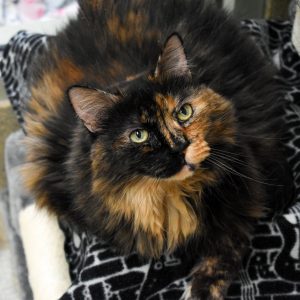 We believe the world is our catwalk, but not in the empowering way. Perhaps high-wire is a more apt image. We are aloft, achingly visible, alert to always being seen. So scrambled are we by the sight of onlookers, we forget that we have sunny-side eyes of our own.
We believe the world is our catwalk, but not in the empowering way. Perhaps high-wire is a more apt image. We are aloft, achingly visible, alert to always being seen. So scrambled are we by the sight of onlookers, we forget that we have sunny-side eyes of our own.
Cats do not forget.
Consider the most objectively beautiful cats in the realm. (This is a challenge, speaking of a species in which every member is a 10/10, by any rubric, body and soul.) I speak of the Fayes and the Elliots, the Roxies and the Stefans, the ones who get approximately seven thousand online adoption applications from Bayonne to Bangladesh on a weekly basis.
(One of the most frequent emails we send at Tabby’s Place: “Please note that we are located in New Jersey.” Not that we can blame our star-crossed adoption-hopefuls a half a world away.)
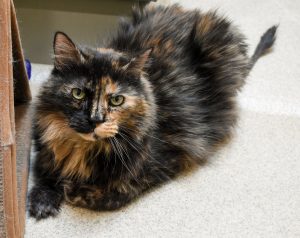 Roxy is radiance incarnate. She is electrified beauty. She is incandescence itself. If, at birth, each cat was granted a garden and the calling to till it to the best of her ability, Roxy somehow got gifted the actual Garden of Eden, and has been making it a masterpiece ever since. Roses tumble over her trellis. Trees of life sprout between her boundless fig-and-tangerine hairs. She is a thing to behold.
Roxy is radiance incarnate. She is electrified beauty. She is incandescence itself. If, at birth, each cat was granted a garden and the calling to till it to the best of her ability, Roxy somehow got gifted the actual Garden of Eden, and has been making it a masterpiece ever since. Roses tumble over her trellis. Trees of life sprout between her boundless fig-and-tangerine hairs. She is a thing to behold.
She has no interest in being either a thing or beheld.
Fully alive, the fire-flecked beauty of Suite A is too busy seeing to stress over being seen. Where we see a glamazon, she sees a samurai; where we would place her perfection in a Museum of Gorgeous, under painstakingly perfect lighting, behind touch-me-not glass, she prefers to pounce on the ragged and the real, where life lives.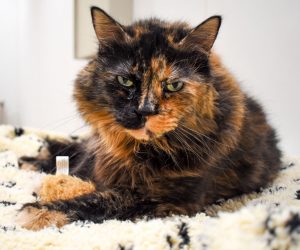
Her gaze is greedy, gobbling up oddities and revelations. She takes it all in: your buttons are pearly. Tonight’s sacred offering includes shrimplets the size of lentils. That volunteer was playing Candy Crush again, and the colors are spectacular. That staff member had sad eyes again, and no one else noticed, but that’s what long-haired lap-occupiers with fire-fur are for, is it not? At least, it is, if they have eyes to see.
Cats all do.
If you should tell her that she’s stunning — and you will, for we humans are adorably incapable of not reminding cats things they already know — she would cock her heavenly head and say, “Huh. That again. You have identified the single least interesting fact about me. But you are human, and bagel-brained, so I shall take you by your grubby, grabby hand and show you a new way of seeing.”
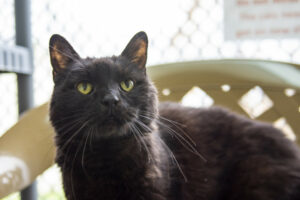 Next door and just as nattily dressed, silken Stefan has seen the same light. (Accurately) declared “fawncy” upon arrival at Tabby’s Place, the dude who defines “debonair” is one wry wink away from the cover of People magazine. (Let the record show that this would be a mild insult, as cats greatly prefer being their own kind of people to “people” people.) He is the magazine editor in a meticulously fitted black turtleneck; he is the baritone who makes even country bumpkins swoon at the opera; he is the neutron star who effortlessly attracts endless ogling.
Next door and just as nattily dressed, silken Stefan has seen the same light. (Accurately) declared “fawncy” upon arrival at Tabby’s Place, the dude who defines “debonair” is one wry wink away from the cover of People magazine. (Let the record show that this would be a mild insult, as cats greatly prefer being their own kind of people to “people” people.) He is the magazine editor in a meticulously fitted black turtleneck; he is the baritone who makes even country bumpkins swoon at the opera; he is the neutron star who effortlessly attracts endless ogling.
His vocation is elsewhere.
Stefan, like Roxy, would tell you — patiently, placidly, with a faintly Swiss accent — that being beheld is swell, but it’s ultimately a distraction from the really scrumptious stuff. If he stumbled too long over being seen, he just might forget to see, to behold, to be brave, and so to be there for life itself. The neurotic mirror, the thrumbling voice of some suspected “them,” would blind his starry eyes to the quiet callings on his actual life.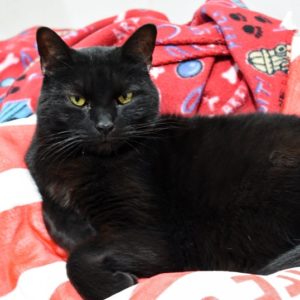
The sight of a volunteer in need of nurture. Stefan is an archaeologist of emotions, uncanny at unearthing hidden hieroglyphs of hurt and hug-hunger. But only because he sees.
The glimpse of an Executive Director starving for a laugh. Stefan is a swami of silliness, guardian of a garden of goofosity, prepared to pluck funny flowers for harried humans at a moment’s notice. But only because he sees.
The look of a cat in need of a serious and sustained beatdown. Stefan is capable of using his sight for good and for…good in his own mind. But only because he sees. (And has an ego the size of the entire Alps, but I digress.)
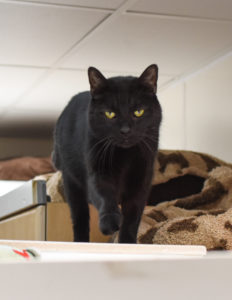 Stefan’s eyes are not on himself, much less on the selves drinking him in. And it’s the heart of his vocation to show us his way. The stakes are high.
Stefan’s eyes are not on himself, much less on the selves drinking him in. And it’s the heart of his vocation to show us his way. The stakes are high.
Spend too long looking at yourself — or, even worse, looking at yourself being looked at or looked over or picked over or passed over — and you’ll forget to look long and lusciously upon the world.
You’ll miss the sights that should make you shout and sigh.
You’ll ogle yourself instead of the opportunities to look and leap and love and give.
You’ll fail to be catlike, and you know that’s one of the greatest tragedies in life.
But perhaps we should be gentle with our own gorgeously gawky species. We’re trained from the earliest age to be hyper-conscious of being seen. It’s not inherently awful to want our teachers and our sweethearts and our personal peanut galleries to think we’re pretty and precocious and interesting and intergalactic. It might cause problems in our relationships and businesses and international relations if we were completely catlike, blind to the eyes of the other.
It’s okay to see ourselves being seen.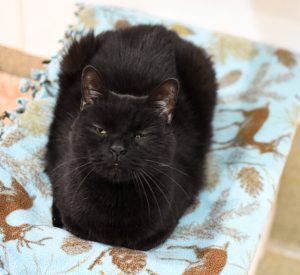
But only if we don’t blind ourselves to the power of our own sight.
Around the time I turned thirty, I became inexplicably, uncontrollably obsessed with photography. I obtained a real camera (the kind that can’t send text messages); I took a class with far smarter, cooler people than myself; I made myself a mission to photograph every single church within Hunterdon County. It was one of the best experiences of my life. I was invisible, pure sight, fully focused on the wonders and wails and warmth and weirdness around me. I swear I learned to love better, listen deeper, and lose myself in the luscious dance just a little longer than before.
And then one day, happily strolling down the street with my Nikon, it happened. A Buick rolled by, and a leering scrub burst my bubble: “I wanna take some pictures of YOU!”
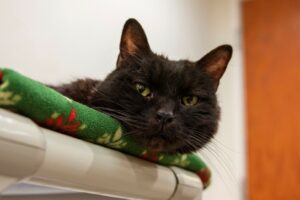 I was frightened, flustered, flattered all at once, then ashamed at having been flattered at all. I still wanted to be seen. (Not by this particular specimen in his faded Metallica T-shirt, but by someone.) I looked at what I was wearing, tucked my hair behind my ears, evaluated myself instead of the great spitfire world around me. And as I felt my legs wobble and heard my song get sucked out of my own ears, I realized: it is a challenging thing to remain a seer.
I was frightened, flustered, flattered all at once, then ashamed at having been flattered at all. I still wanted to be seen. (Not by this particular specimen in his faded Metallica T-shirt, but by someone.) I looked at what I was wearing, tucked my hair behind my ears, evaluated myself instead of the great spitfire world around me. And as I felt my legs wobble and heard my song get sucked out of my own ears, I realized: it is a challenging thing to remain a seer.
Challenging, but not impossible.
We can remind each other that, just as every cat is a seer and a be-er and a prophet in her own right, so can we grow gardens and grow courage and grow past the limits of looking at ourselves.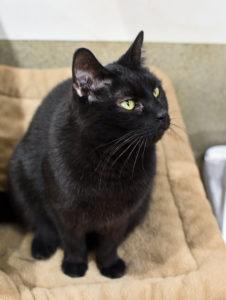
Our purpose is not to be pressed roses.
Our purpose is not to moulder away under museum glass.
Our purpose is to lose and find ourselves in seeing each other, making each other feel seen, seeing past the limits of sight.
So let’s see what we can do here together.
Let’s see the glory and the grief, the gauze and the glitter, the secret needs and sacred stories that are calling for us to live our real calling.
Let’s stop looking at ourselves.
And let’s follow our lead actors, wise and whiskered and weirder than we’ll ever have courage to be, as we all make the scene that matters, the one on which the curtain never closes.
